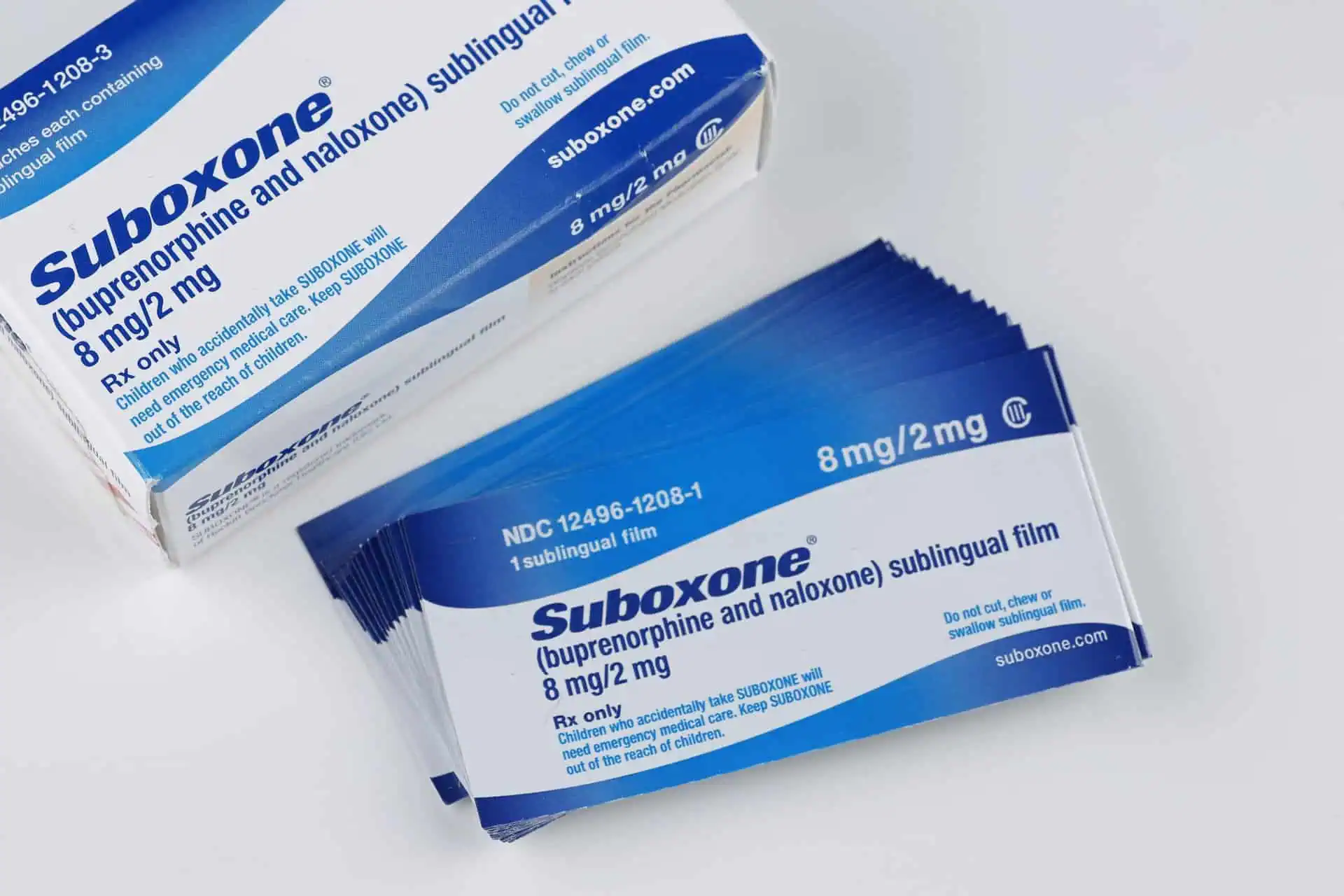Suboxone Withdrawal Symptoms and Recovery Timeline
- Last Updated: July 14th, 2025

Attorney Jessica Paluch-Hoerman, founder of TruLaw, has over 28 years of experience as a personal injury and mass tort attorney, and previously worked as an international tax attorney at Deloitte. Jessie collaborates with attorneys nationwide — enabling her to share reliable, up-to-date legal information with our readers.
Legally Reviewed
This article has been written and reviewed for legal accuracy and clarity by the team of writers and legal experts at TruLaw and is as accurate as possible. This content should not be taken as legal advice from an attorney. If you would like to learn more about our owner and experienced injury lawyer, Jessie Paluch, you can do so here.
Fact-Checked
TruLaw does everything possible to make sure the information in this article is up to date and accurate. If you need specific legal advice about your case, contact us by using the chat on the bottom of this page. This article should not be taken as advice from an attorney.
Key takeaways:
- Suboxone withdrawal symptoms can vary in intensity and duration based on factors like dosage, length of use, and individual health, with physical and psychological effects often peaking within the first week.
- Coping strategies for Suboxone withdrawal include medication-assisted treatment to ease symptoms, lifestyle changes like a healthy diet and exercise, and ongoing psychological support.
- Medically supervised Suboxone detox is crucial for managing withdrawal safely, minimizing relapse risk, monitoring for complications, and integrating with comprehensive addiction treatment for long-term recovery.
Overview of Suboxone Withdrawal
On this page, we’ll discuss Suboxone withdrawal, common signs and symptoms of Suboxone withdrawal, how to manage common Suboxone withdrawal symptoms, and much more.
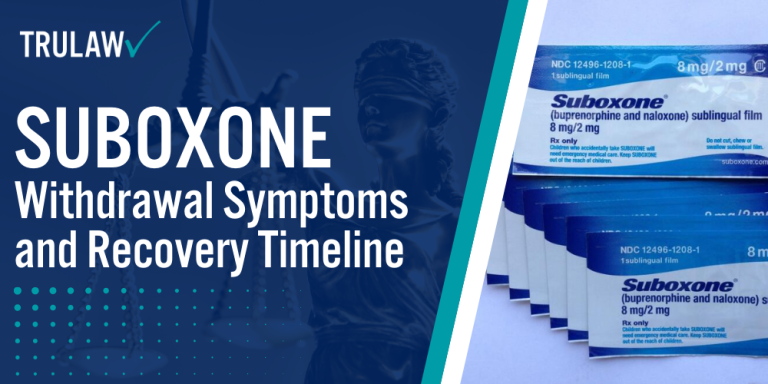
Intro to Suboxone Withdrawal
Key aspects of Suboxone withdrawal include, but are not limited to:
- Withdrawal Symptoms: Suboxone withdrawal can cause a range of symptoms, including anxiety, depression, insomnia, sweating, muscle aches, and gastrointestinal distress.
- Onset and Duration: The onset and duration of Suboxone withdrawal symptoms can vary depending on factors such as the length of Suboxone use and individual physiology.
- Management Strategies: Managing Suboxone withdrawal may involve a gradual tapering of the medication, supportive care, and addressing any co-occurring mental health or medical conditions.
- Professional Support: Seeking professional medical and addiction treatment support can be crucial in navigating Suboxone withdrawal and maintaining long-term recovery.
If you are considering discontinuing Suboxone use or are experiencing withdrawal symptoms, it’s essential to consult with a healthcare professional to ensure a safe and effective withdrawal process.
Contact Tru Law using the chat on this page for a free consultation to discuss your Suboxone withdrawal concerns and potential legal options related to Suboxone-induced dental problems.
Table of Contents
What Happens During Suboxone Withdrawal?
When a person stops taking Suboxone, a medication used to treat opioid dependence, they may experience a range of withdrawal symptoms.
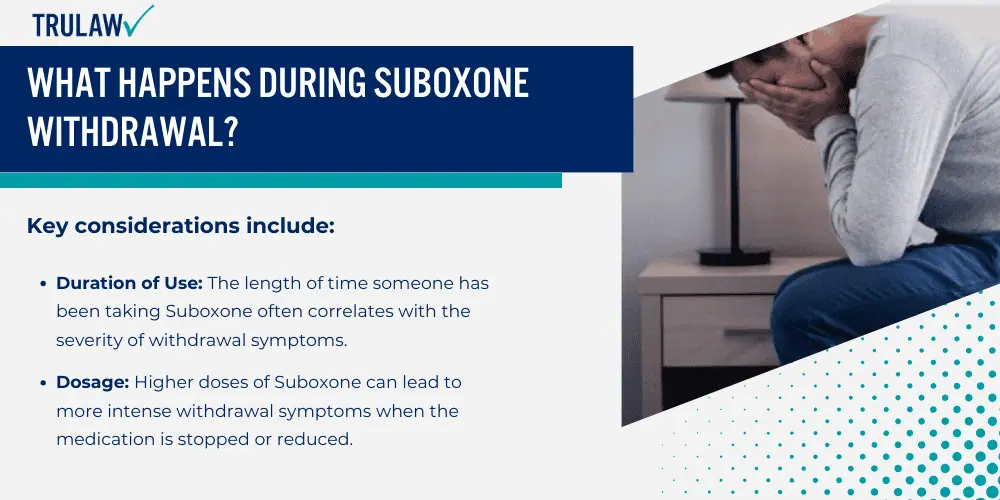
These symptoms can vary in intensity and duration based on several factors.
Factors Influencing Suboxone Withdrawal Severity
Withdrawal from Suboxone can be influenced by various factors, making the experience fairly unique for each person.
Key considerations include:
- Duration of Use: The length of time someone has been taking Suboxone often correlates with the severity of withdrawal symptoms.
- Dosage: Higher doses of Suboxone can lead to more intense withdrawal symptoms when the medication is stopped or reduced.
- Individual Metabolism: Variations in a person’s metabolism can affect how quickly Suboxone is processed and eliminated from the body.
- Physical Health: Overall health can affect the intensity and duration of withdrawal symptoms.
- Psychological Factors: Mental health and personal stress levels can impact how severe withdrawal symptoms feel.
- Support systems: A strong support system can help alleviate the perception of withdrawal severity.
Withdrawal symptoms can include nausea, headaches, mood swings, and insomnia.
In cases where Suboxone is discontinued abruptly, symptoms may be more severe.
On the other hand, a gradual tapering of the medication, as part of a professionally supervised treatment plan, can often help to reduce the severity of withdrawal symptoms.
Early Suboxone Withdrawal Symptoms (Days 1-3)
The initial days following the cessation of Suboxone are marked by the onset of withdrawal symptoms.
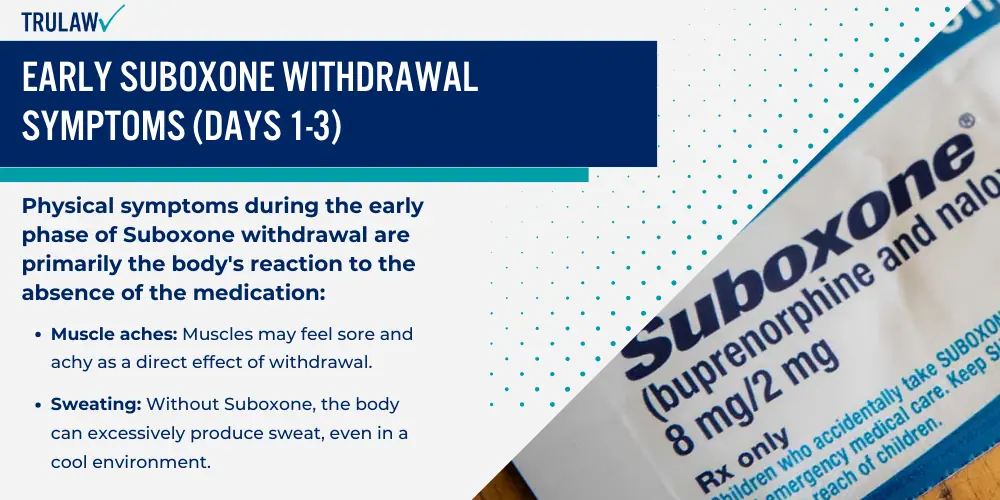
These are typically divided into physical and psychological categories.
Physical Symptoms of Early Suboxone Withdrawal
The first few days of Suboxone withdrawal can bring about various physical symptoms as the body adjusts to the absence of the medication.
These physical symptoms are the body’s direct reaction to no longer having Suboxone in its system.
Physical symptoms during the early phase of Suboxone withdrawal are primarily the body’s reaction to the absence of the medication:
- Muscle aches: Muscles may feel sore and achy as a direct effect of withdrawal.
- Sweating: Without Suboxone, the body can excessively produce sweat, even in a cool environment.
- Chills: Conversely, individuals might experience sudden chills.
- Headaches: Painful headaches are a common physical complaint.
- Fatigue: A pervasive sense of tiredness often makes normal activities challenging.
Psychological Symptoms of Early Suboxone Withdrawal
Along with the physical symptoms, individuals with early Suboxone withdrawal often experience psychological effects as well.
These mental and emotional symptoms can be just as challenging as the physical ones.
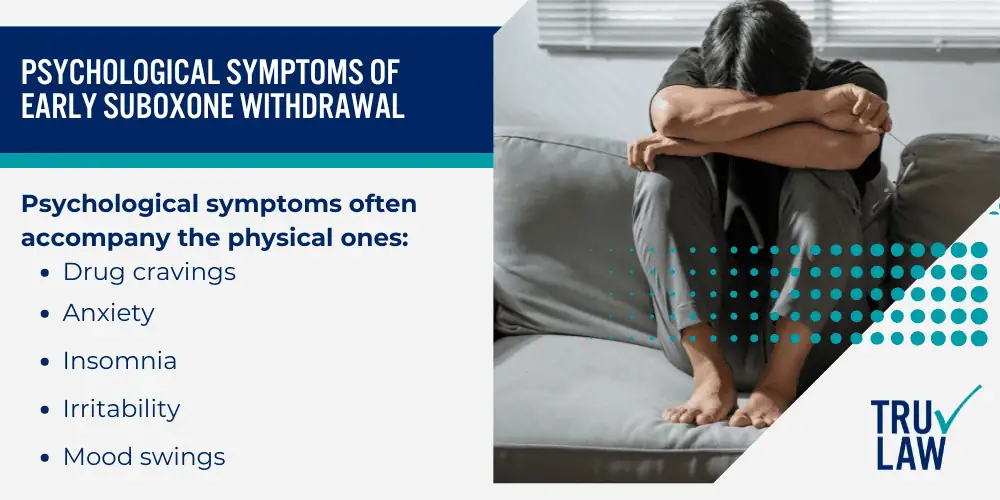
Psychological symptoms often accompany the physical ones:
- Drug cravings: Intense desires for Suboxone or other opioids can manifest early in the withdrawal process.
- Anxiety: The absence of Suboxone can lead to feelings of anxiety.
- Insomnia: Difficulty falling or staying asleep is a common psychological symptom.
- Irritability: Many individuals become more easily frustrated or agitated.
- Mood swings: Emotional states can fluctuate rapidly without warning.
Understanding this early symptomatology is essential for individuals who are transitioning away from Suboxone, as well as for healthcare professionals who are supporting them through this period.
Peak Suboxone Withdrawal Symptoms (Days 4-7)
During days 4 to 7, individuals undergoing Suboxone withdrawal often experience the most intense symptoms as the body continues adjusting to the absence of the drug it has developed a physical dependence on.
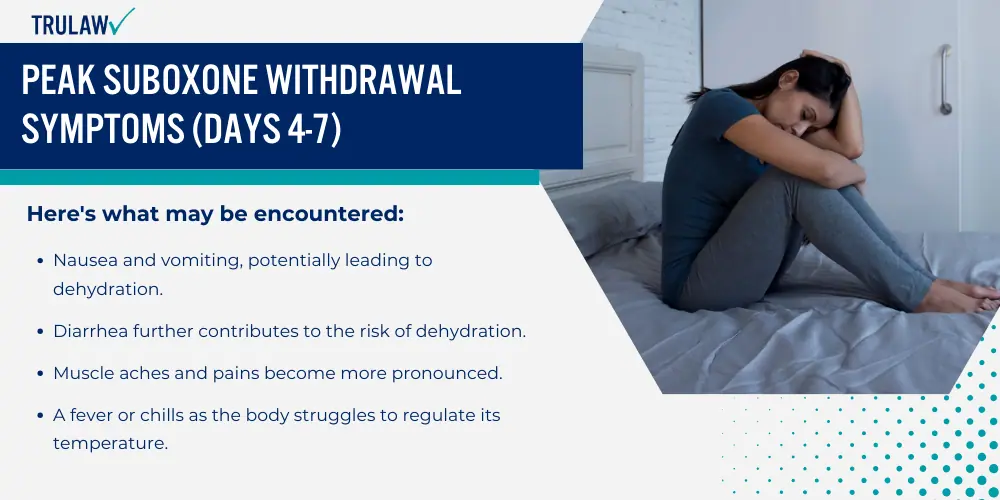
Intensification of Physical Suboxone Withdrawal Symptoms
Symptoms of opioid withdrawal can significantly intensify during this period.
Here’s what may be encountered:
- Nausea and vomiting, potentially leading to dehydration.
- Diarrhea further contributes to the risk of dehydration.
- Muscle aches and pains become more pronounced.
- A fever or chills as the body struggles to regulate its temperature.
These symptoms are part of the process as the body clears the remaining buprenorphine from its system and starts to recalibrate.
Emotional and Mental Challenges During Peak Withdrawal
In addition to the physical symptoms, the peak phase of Suboxone withdrawal also brings significant emotional and mental challenges.
Managing these psychological effects is a critical part of the withdrawal process.
Mental health is equally affected in this phase of withdrawal:
- Increased anxiety and irritability can complicate personal interactions.
- Mood swings that range from agitation to periods of intense sadness.
- Trouble with concentration, making it difficult to perform even simple tasks.
- Sleep disturbances, including insomnia, can exacerbate other withdrawal symptoms.
It’s during this time frame that the combination of physical and mental health challenges can feel overwhelming.
However, it’s a critical phase that allows withdrawal symptoms to subside and a gradual return to equilibrium.
Late Suboxone Withdrawal Symptoms (Weeks 2-4)
In the weeks following the acute phase of Suboxone withdrawal, individuals typically experience a spectrum of lingering physical and emotional symptoms.
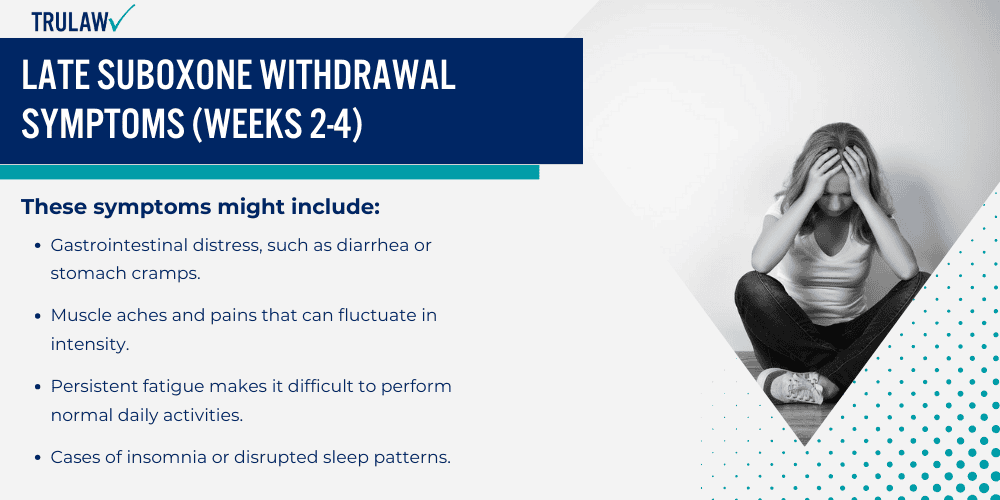
These symptoms can affect daily functioning and well-being.
Lingering Physical Symptoms of Suboxone Withdrawal
Suboxone withdrawal can impact the central nervous system well into the second to fourth week, with physical symptoms that can persist at varying intensities.
These symptoms might include:
- Gastrointestinal distress, such as diarrhea or stomach cramps.
- Muscle aches and pains that can fluctuate in intensity.
- Persistent fatigue makes it difficult to perform normal daily activities.
- Cases of insomnia or disrupted sleep patterns.
- Ongoing headaches or migraines.
- Potential for flu-like symptoms that come and go.
Psychological and Emotional Adjustment After Acute Withdrawal
Post-acute withdrawal from Suboxone also signifies a transition period for mental health, where psychological support may be beneficial.
The following symptoms often necessitate attention from the mental health services administration:
- Feelings of anxiety or panic attacks can ebb and flow in severity.
- Episodes of depression that may require professional guidance.
- Difficulty with concentration and memory — tasks may take more effort.
- Cravings for Suboxone or other opioids fluctuate throughout this period.
Adjusting to life without Suboxone often includes coping with emotional volatility and relearning how to manage stress without relying on substances.
Post-Acute Suboxone Withdrawal Syndrome (PAWS)
Following the cessation of Suboxone, a long-acting opioid used in the treatment of opioid addiction, individuals may experience a second phase of withdrawal symptoms known as Post-Acute Suboxone Withdrawal Syndrome (PAWS).
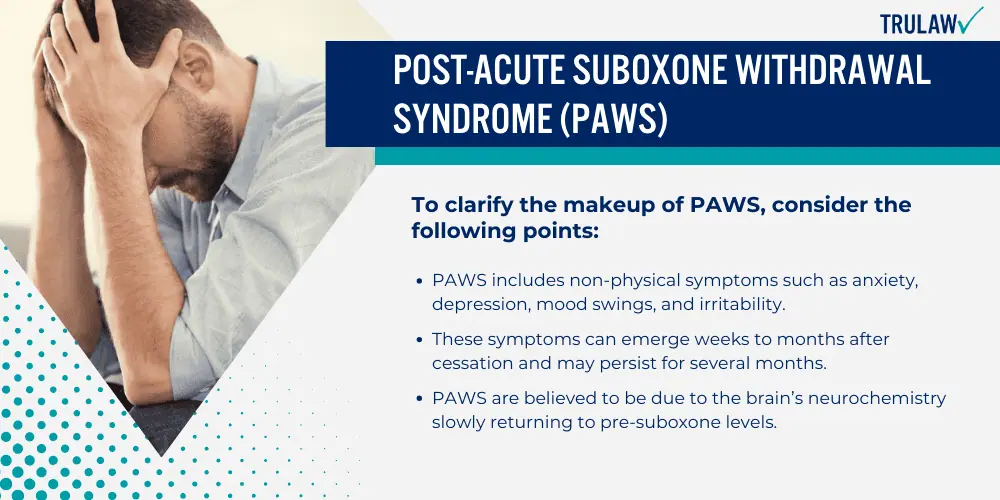
These symptoms often require a different approach than the initial withdrawal phase, and understanding as well as managing them is key to successful recovery.
Understanding PAWS After Suboxone Discontinuation
The discontinuation of Suboxone can lead to a prolonged withdrawal phase that is characterized by a set of symptoms dissimilar to the acute phase.
Medically supervised Suboxone detox is often recommended to mitigate early withdrawal symptoms; however, PAWS presents a separate challenge.
To clarify the makeup of PAWS, consider the following points:
- PAWS includes non-physical symptoms such as anxiety, depression, mood swings, and irritability.
- These symptoms can emerge weeks to months after cessation and may persist for several months.
- PAWS are believed to be due to the brain’s neurochemistry slowly returning to pre-suboxone levels.
- Emotional and cognitive symptoms are forefront, as the patient no longer experiences the direct physical effects of Suboxone.
Managing PAWS Symptoms in Suboxone Recovery
Effective management of PAWS involves a supportive approach that balances medical intervention with lifestyle adjustments.
Ease of withdrawal symptoms is a significant concern for individuals and healthcare providers alike.
Strategies to address PAWS symptoms might include:
- Continuation of psychological support, including therapy or support groups, to manage emotional distress.
- Physical activity promotes endorphin production and improves mood.
- A structured routine to provide stability and reduce anxiety.
- Pharmacological options, under the guidance of a healthcare professional, may be beneficial in certain cases.
Successfully managing PAWS requires patience and a comprehensive support system to reduce the risk of relapse.
While Suboxone serves to aid in the initial detoxification from opioids, the aftercare for PAWS is equally important for long-term sobriety and health.
Suboxone Withdrawal Timeline and Variability
When discontinuing Suboxone, a medication used in the treatment of opioid addiction, patients may experience withdrawal symptoms that vary in duration and severity.
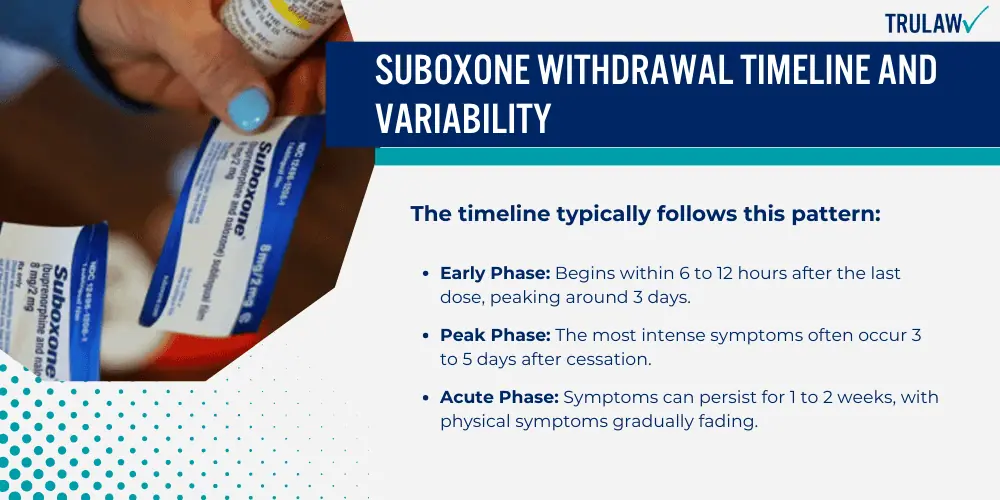
This can reflect individual health factors and treatment protocols.
Typical Duration of Suboxone Withdrawal Phases
Suboxone withdrawal symptoms can manifest in phases.
The timeline typically follows this pattern:
- Early Phase: Begins within 6 to 12 hours after the last dose, peaking around 3 days.
- Peak Phase: The most intense symptoms often occur 3 to 5 days after cessation.
- Acute Phase: Symptoms can persist for 1 to 2 weeks, with physical symptoms gradually fading.
- Post-Acute Withdrawal Syndrome (PAWS): Some individuals may experience prolonged symptoms like anxiety and depression for months.
These phases reflect general patterns observed in patients with opioid dependence undergoing Suboxone cessation.
Individual Differences in Suboxone Withdrawal Timelines
Individual factors play a significant role in the withdrawal experience.
While the general timeline provides a framework for understanding Suboxone withdrawal, it’s important to recognize that each person’s experience may differ.
Several factors can influence the duration and severity of Suboxone withdrawal symptoms:
- Metabolism: A faster metabolism can shorten the withdrawal duration.
- Duration of Use: Longer use can lead to more protracted withdrawal.
- Dosage: Higher Suboxone dosages may result in a more extended withdrawal period.
- Underlying Health: Co-occurring medical or mental health conditions may influence symptom intensity and duration.
Understanding the variability among individuals is important for tailoring treatment strategies and managing expectations regarding Suboxone withdrawal.
Coping Strategies for Suboxone Withdrawal Symptoms
Withdrawal from Suboxone can be challenging, but there are proven strategies to manage discomfort and ease symptoms.
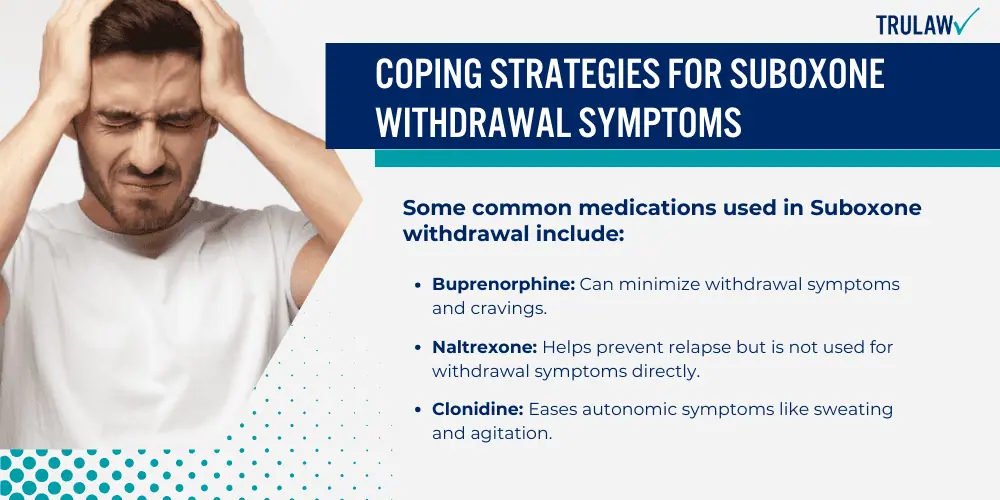
These approaches range from medication-assisted treatment to lifestyle modifications.
Medications for Managing Suboxone Withdrawal Discomfort
Medication-assisted treatment (MAT) is an effective way to alleviate Suboxone withdrawal symptoms.
MAT often includes the use of treatment medications specifically approved for opioid dependency.
Some common medications used in Suboxone withdrawal include:
- Buprenorphine: Can minimize withdrawal symptoms and cravings.
- Naltrexone: Helps prevent relapse but is not used for withdrawal symptoms directly.
- Clonidine: Eases autonomic symptoms like sweating and agitation.
- OTC Pain Relievers: May reduce discomfort from body aches and headaches.
Patients seeking medical assistance should consider a medical detox program, which typically provides these medications under supervision.
Lifestyle Interventions for Easing Suboxone Withdrawal
Lifestyle changes can also play a role in managing withdrawal symptoms.
Here are some practical interventions:
- Healthy Diet: Eating balanced meals can help the body heal.
- Hydration: Drinking plenty of water is essential for detoxification.
- Physical Activity: Light exercise may alleviate mood swings and stress.
- Regulated Sleep: Good sleep promotes recovery and reduces fatigue.
Incorporating these methods can support individuals through the withdrawal phase and increase the likelihood of successful recovery.
For guidance on these treatments, refer to authoritative sources like the National Institute on Drug Abuse.
Importance of Medical Supervision During Suboxone Withdrawal
Withdrawing from Suboxone, a medication containing buprenorphine, an opioid agonist, and naloxone, demands careful oversight.
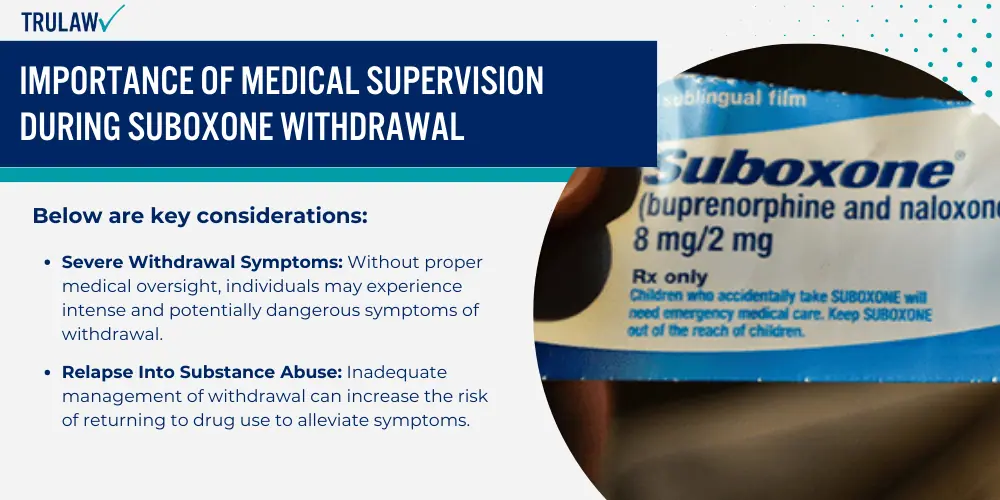
Medical detox can significantly influence the safety and effectiveness of the process, particularly at American Addiction Centers that specialize in addiction treatment.
Risks of Unsupervised Suboxone Withdrawal
Unsupervised withdrawal can lead to unnecessary discomfort and health risks.
Below are key considerations:
- Severe Withdrawal Symptoms: Without proper medical oversight, individuals may experience intense and potentially dangerous symptoms of withdrawal.
- Relapse Into Substance Abuse: Inadequate management of withdrawal can increase the risk of returning to drug use to alleviate symptoms.
- Health Complications: Withdrawal can exacerbate underlying health issues, posing potential complications.
- Mental Health Concerns: Alongside physical challenges, unsupervised detox may provoke or worsen mental health conditions without immediate support available.
Benefits of Medically-Assisted Suboxone Withdrawal
Medically-assisted Suboxone withdrawal offers many advantages compared to trying to detox alone.
With proper medical support, individuals can withdraw from Suboxone more comfortably and safely.
Medically-assisted withdrawal provides several advantages over unsupervised attempts:
- Proper Management of Symptoms: Detoxing under medical supervision can ensure comfort and reduce withdrawal intensity.
- Prevention of Relapse: Medical professionals can offer the necessary support to prevent a return to drug abuse.
- Monitoring for Complications: Continuous health monitoring minimizes the risk of complications.
- Integration into Further Treatment: Supervised detox often serves as an initial step to a comprehensive addiction treatment, paving the way for long-term recovery.
Suboxone Lawsuit Frequently Asked Questions
-
During Suboxone withdrawal, individuals may experience symptoms such as nausea, headaches, sweating, and mood swings.
These side effects can vary in intensity from person to person.
-
The withdrawal process from Suboxone usually begins within a few days after the last dose and can last for several weeks, with the acute phase peaking around one to two weeks.
-
Methods to soothe withdrawal symptoms may include hydration, over-the-counter pain relievers, and consulting with a healthcare provider for other medication-assisted treatments.
-
Stopping Suboxone abruptly can result in a rapid onset of withdrawal symptoms, which may be severe.
It is advised to taper down the dosage under medical supervision to reduce these risks.
-
Yes, long-term use of Suboxone can lead to physical dependence, despite its use in treating opioid dependence.
Dependence is a possibility even when Suboxone is used as prescribed.
-
Suboxone withdrawal can be less intense than withdrawal from other opioids due to its longer half-life, which allows for a slower reduction of blood levels.
However, the duration of withdrawal might be longer.

Managing Attorney & Owner
With over 25 years of legal experience, Jessica Paluch-Hoerman is an Illinois lawyer, a CPA, and a mother of three. She spent the first decade of her career working as an international tax attorney at Deloitte.
In 2009, Jessie co-founded her own law firm with her husband – which has scaled to over 30 employees since its conception.
In 2016, Jessie founded TruLaw, which allows her to collaborate with attorneys and legal experts across the United States on a daily basis. This hypervaluable network of experts is what enables her to share the most reliable, accurate, and up-to-date legal information with our readers!
Additional Suboxone Lawsuit resources on our website:
Here, at TruLaw, we’re committed to helping victims get the justice they deserve.
Alongside our partner law firms, we have successfully collected over $3 Billion in verdicts and settlements on behalf of injured individuals.
Would you like our help?
At TruLaw, we fiercely combat corporations that endanger individuals’ well-being. If you’ve suffered injuries and believe these well-funded entities should be held accountable, we’re here for you.
With TruLaw, you gain access to successful and seasoned lawyers who maximize your chances of success. Our lawyers invest in you—they do not receive a dime until your lawsuit reaches a successful resolution!
AFFF Lawsuit claims are being filed against manufacturers of aqueous film-forming foam (AFFF), commonly used in firefighting.
Claims allege that companies such as 3M, DuPont, and Tyco Fire Products failed to adequately warn users about the potential dangers of AFFF exposure — including increased risks of various cancers and diseases.
Depo Provera Lawsuit claims are being filed by individuals who allege they developed meningioma (a type of brain tumor) after receiving Depo-Provera birth control injections.
A 2024 study found that women using Depo-Provera for at least 1 year are five times more likely to develop meningioma brain tumors compared to those not using the drug.
Suboxone Tooth Decay Lawsuit claims are being filed against Indivior, the manufacturer of Suboxone, a medication used to treat opioid addiction.
Claims allege that Indivior failed to adequately warn users about the potential dangers of severe tooth decay and dental injuries associated with Suboxone’s sublingual film version.
Social Media Harm Lawsuits are being filed against social media companies for allegedly causing mental health issues in children and teens.
Claims allege that companies like Meta, Google, ByteDance, and Snap designed addictive platforms that led to anxiety, depression, and other mental health issues without adequately warning users or parents.
Transvaginal Mesh Lawsuits are being filed against manufacturers of transvaginal mesh products used to treat pelvic organ prolapse (POP) and stress urinary incontinence (SUI).
Claims allege that companies like Ethicon, C.R. Bard, and Boston Scientific failed to adequately warn about potential dangers — including erosion, pain, and infection.
Bair Hugger Warming Blanket Lawsuits involve claims against 3M — alleging their surgical warming blankets caused severe infections and complications (particularly in hip and knee replacement surgeries).
Plaintiffs claim 3M failed to warn about potential risks — despite knowing about increased risk of deep joint infections since 2011.
Baby Formula NEC Lawsuit claims are being filed against manufacturers of cow’s milk-based baby formula products.
Claims allege that companies like Abbott Laboratories (Similac) and Mead Johnson & Company (Enfamil) failed to warn about the increased risk of necrotizing enterocolitis (NEC) in premature infants.
Here, at TruLaw, we’re committed to helping victims get the justice they deserve.
Alongside our partner law firms, we have successfully collected over $3 Billion in verdicts and settlements on behalf of injured individuals.
Would you like our help?
